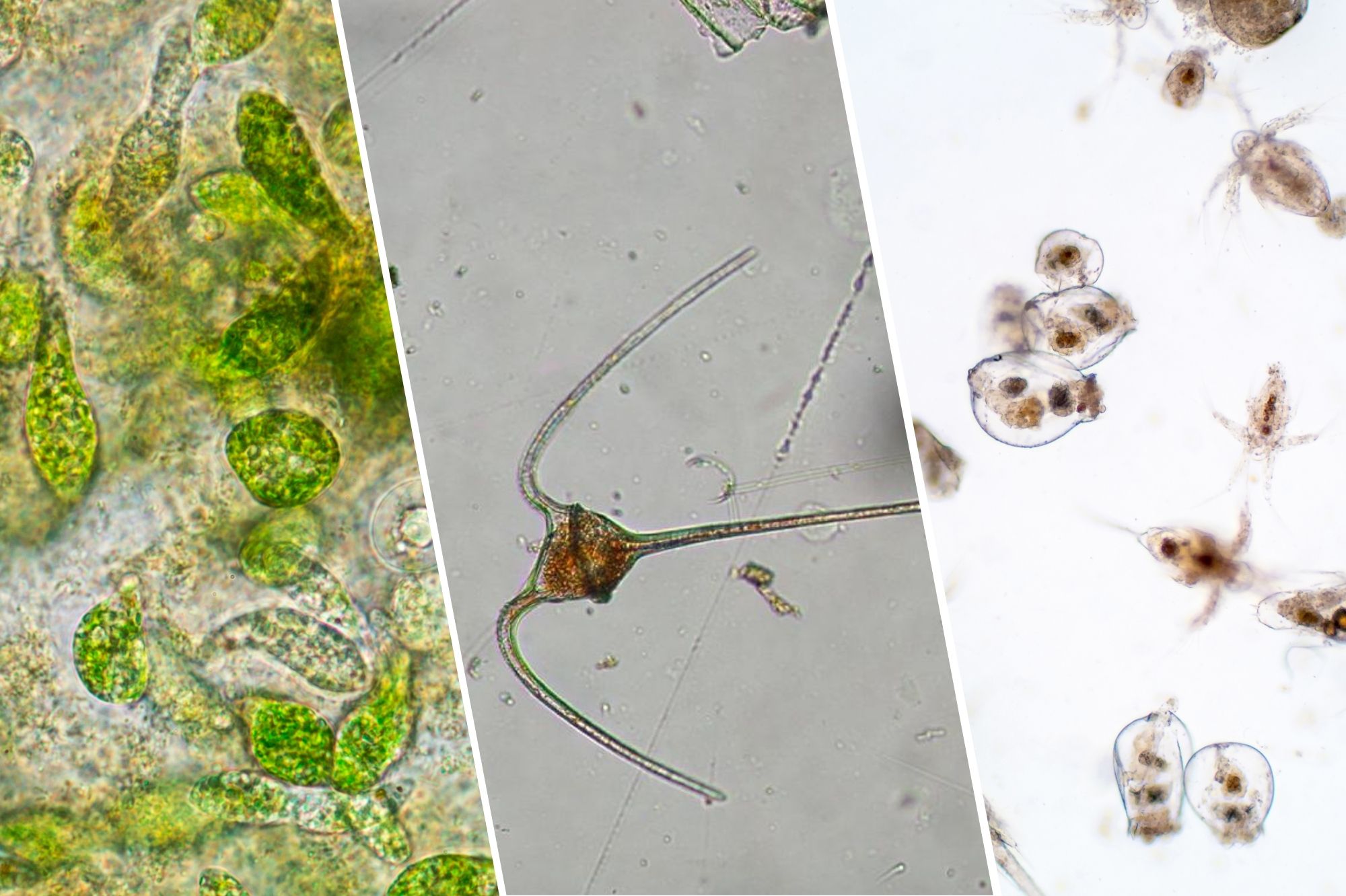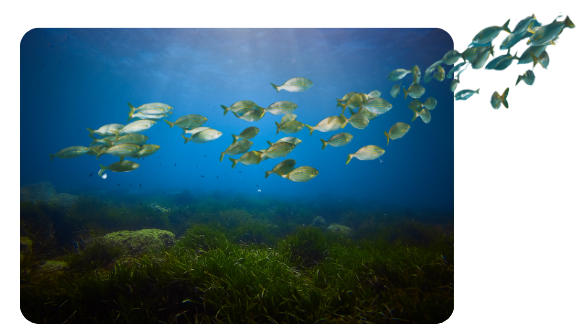Story
Think you know your mixoplankton from your phytoplankton?
08 May 2025
Outdated terms are clouding our view of marine ecosystems – it’s time to update the vocabulary, writes Professor Kevin Flynn.

Why Words Matter: Rethinking How We Talk About Plankton
In science, precision is power. It’s how we build knowledge, share discoveries, and inform the decisions that shape our world. But what happens when the language we use, especially in complex fields like marine ecology, oversimplifies reality?
Plankton – a diverse group of mostly microscopic organisms that essentially drift with ocean currents – are a perfect example of this problem. They play a vital role in everything from global climate regulation to food security. Yet despite their importance, plankton are often described using outdated or misleading terms – even (or perhaps, especially) by scientists.
And that’s a problem. Because when we mislabel these organisms, we risk misunderstanding how marine ecosystems work. Worse still, these misunderstandings filter through scientific communication into policymaking, education, and public perception – where the consequences can really add up.
The Problem with Plankton Terminology
The most common way plankton are described is by splitting them into two camps: phytoplankton (the “plant-like” ones that photosynthesise) and zooplankton (the “animal-like” ones that feed on others). It’s simple. It’s catchy. It aligns with the comfort zone of the public perception of terrestrial ecology. But it’s wrong.
Why? Because many, actually most, planktonic organisms don’t fit neatly into these boxes. In recent years, marine science has revealed just how flexible and complex plankton nutrition can be. For example, a huge number of planktonic protists – tiny, single-celled eukaryotes – don’t just photosynthesise or graze: they do both. These are known as mixoplankton, and they’ve been hiding in plain sight.
Mixoplankton blur the lines between producers and consumers. They fix carbon through photosynthesis, absorb dissolved organics, and also engulf prey. This isn’t a rare exception – it’s widespread, and many common plankton species are in this group. And it’s not just a fun fact for biologists: it fundamentally alters how we understand marine food webs and nutrient cycling.
Yet despite this, many scientists and communicators still fall back on the phytoplankton/zooplankton dichotomy. It’s convenient, but it gives the wrong impression – not just to non-specialists like environmental managers, educators, and the public, but equally for specialists in marine science.
The Consequences of Confusing Language
Imagine you’re a policy advisor tasked with managing a marine protected area. You’re told that phytoplankton are like plants, zooplankton are like herbivores, and that’s how the ecosystem functions. Based on that, you might make assumptions about nutrient flows, productivity, or even responses to climate change that don’t hold up to scrutiny. And you wouldn’t be alone.
Terms like “herbivore,” “carnivore,” or “planktonic plants” create misleading analogies. They bring terrestrial imagery into the ocean – but the ocean doesn’t work like a field of grass being grazed by cows. In fact, planktonic ecosystems are some of the most complex and dynamic on the planet. Using oversimplified terminology risks flattening that richness into something unrecognisable. The same applies to descriptions of plankton used in models, in reference to remote sensing images, and even in fisheries science.
Flip it around – as a terrestrial ecologist, would you converse with colleagues or during outreach events using the words ‘plant’ and ‘animal’? Almost certainly if you did, you would stopped in your tracks and asked to clarify whether the plants were grass, shrubs, deciduous trees etc. And those animals – are they worms, insects, birds, cows, or what?
This issue isn’t just theoretical. The recent Plankton Manifesto (2024), a collaborative effort among leading marine scientists including PML’s Professor Kevin Flynn, made a strong case for using consistent plankton terminology. The manifesto stressed the importance of using accurate modern language when discussing plankton – especially in outreach and policy.
A Better Way Forward
So, what terms should we be using?
Here are a few principles drawn from recent research and expert consensus:
- Use “microalgae” as a general term for microscopic photosynthetic organisms. Reserve phytoplankton for those planktonic microalgae that don’t eat – those organisms include the cyanobacteria and diatoms.
- Use “mixoplankton” when referring to microalgae that can both photosynthesise and consume other organisms. This group is far more common than most people realise, including many exemplar ‘phytoplankton’ and also most marine Harmful Algal Bloom (HAB) species.
- Distinguish between “protist zooplankton” (single-celled grazers) and “metazoan zooplankton” (multi-celled animals such as copepods or krill).
- Avoid plant and animal analogies altogether. They often create more confusion than clarity, and they are often just plain wrong.
- Use functional terms like “phototrophy,” “phagotrophy,” and “osmotrophy”, or the suffix ‘trophic (e.g., osmotrophic) to describe how organisms get their energy and nutrients. Avoid using the suffix ‘troph (e.g., phototroph) because most microbial plankton can use at least two of these mechanisms.
| Plankton descriptor | Possible alternatives | Comment |
| Herbivore | Refer to specific organism groups/species | As there are no planktonic plants, the term herbivore is redundant |
| Microplankton | Microbial plankton
Micro-sized plankton |
Microplankton is a size descriptor; many smaller metazoan zooplankton, and certainly their juvenile stages, are microscopic |
| Mixotroph | Phytoplankton (i.e., photo+osmotrophic)
Mixoplankton (i.e., photo+osmo+phagotrophic) |
Mixotroph is ambiguous in general usage because all microalgae are mixotrophic |
| Nanoflagellate | Refer to specific group (i.e., nano protist zooplankton, nano mixoplankton, nano phytoplankton, heterotrophic nanoflagellate) | Nanoflagellate only describes size and the presence of flagella. Do not use photoflagallate except as a catch-all for all motile phytoplankton+mixoplankton |
| Phagotroph | Mixoplankton
Protist zooplankton |
Phagotroph just flags a mode of feeding (and often it is technically incorrect as well) |
| Phototroph | Alter syntax to refer to ‘phototrophic plankton’
Phytoplankton+mixoplankton |
Mixoplankton and phytoplankton are phototrophic |
| Phytoplankton | Microalgae
Microalgal plankton Phytoplankton+mixoplankton Specific organism groups (cyanobacteria, diatom, etc.) |
Do not use phytoplankton as a catch-all for all plankton capable of phototrophy as many of those (especially HAB species) are mixoplankton. |
| Protozoa or
Protozoan zooplankton |
Protist zooplankton | Protozoa (meaning original, or first, animal) is an inappropriate term to describe modern day organisms. |
| Secondary producers | Alter syntax to refer to ‘secondary production’
Refer to specific organism groups/species |
No grazer will consume only phototrophs, and many organisms that are phototrophic are actually mixoplankton or are otherwise capable of mixotrophy. |
| Zooplankton | Protist zooplankton
Metazoan zooplankton Specific organism groups (copepod, krill, etc.) |
Use zooplankton only as a catch-all for all plankton (protist and metazoan) that are solely grazers (i.e., excluding mixoplankton). Do not use it to refer to a specific group, such as copepods. |
Here’s the bottom line: getting the terminology right isn’t about being pedantic. It’s about respecting the complexity of the natural world – and making sure we communicate that complexity effectively to others. Especially when we’re trying to influence decisions that affect the health of our oceans.
By speaking clearly and accurately, we make it easier for others to understand, engage with, and act on the science. And in a world facing mounting environmental challenges, that clarity has never been more important.
Stay tuned:
To celebrate the Spring bloom, over the following days we will continue to share ‘all things plankton’ on our website and social media channels!
